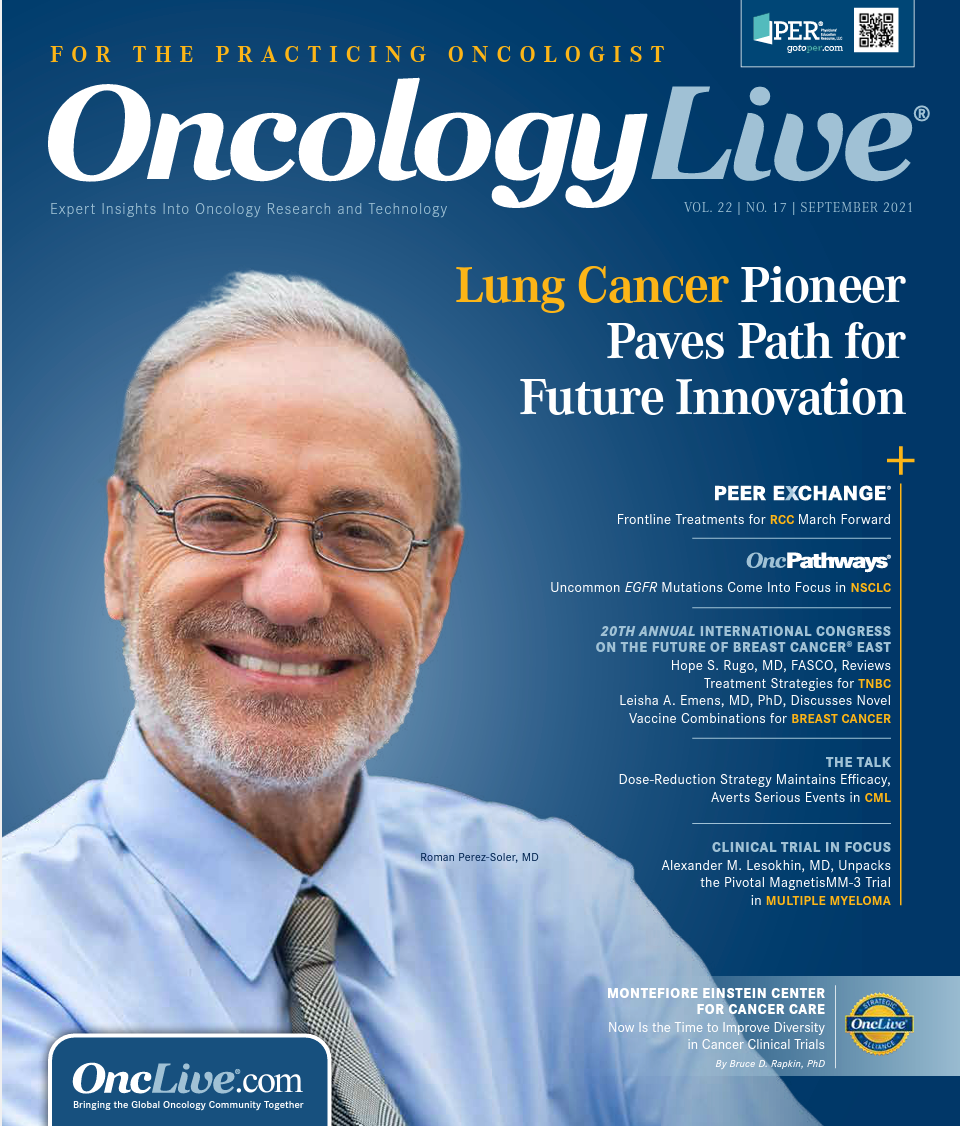Frontline Treatments for Metastatic RCC March Forward
Treatment of metastatic renal cell carcinoma continues to evolve as new regimens steadily receive FDA approval and are added to the armamentarium.
Martin H. Voss, MD

Treatment of metastatic renal cell carcinoma (RCC) continues to evolve as new regimens steadily receive FDA approval and are added to the armamentarium. “[Several] pivotal trials have redefined our practice and shaped the path from monotherapy to considering immuno-oncology [IO]–based combinations for most of our patients,” Martin H. Voss, MD, said during a recent OncLive Peer Exchange®.
Voss was joined by a panel of experts in genitourinary cancer who discussed these pivotal IO trials and shared some of the latest data updates that were presented for these trials at recent oncology meetings, including the 2021 American Society of Clinical Oncology (ASCO) Annual Meeting.
A Shift to IO-Based Combination Regimens
Sandy Srinivas, MBBS

“A lot has changed in the front line in the past many years,” Sandy Srinivas, MBBS, said. She explained that the advent of immunotherapy combinations has resulted in clinicians now using the International Metastatic RCC Database Consortium (IMDC) to classify patients into risk categories to guide treatment selection. “When we had targeted drugs with TKIs [tyrosine kinase inhibitors] and mTOR [inhibitors], we used this IMDC risk classification mostly for prognosis and not really in selecting therapy…. CheckMate 214 [NCT02231749] was the first trial that really changed our practice with integrating risk assessment into treatment groups,” she said.
Srinivas explained that a dual IO treatment and 3 TKI-IO combinations are currently available as first-line treatments for patients with RCC across the different risk groups and have been incorporated into the National Comprehensive Cancer Network (NCCN) Guidelines for kidney cancer (Table1).
Table 1. NCCN Recommended First-Line Treatments for Metastatic or Relapsed Clear Cell RCC1

“We also have TKI monotherapy. It’s becoming less commonly used, but we certainly have our old friends pazopanib [Votrient] and sunitinib [Sutent] as monotherapy for favorable-risk and cabozantinib [Cabometyx] as a mono-therapy for poor-risk [patients],” she said. Srinivas and the panelists proceeded to discuss the pivotal trials that have shifted treatment away from monotherapy and toward the IO-based combinations.
Nivolumab Plus Ipilimumab
On April 16, 2018, the FDA approved nivolumab [Opdivo] plus ipilimumab [Yervoy] for the treatment of treatment-naïve patients with intermediate- or poor-risk advanced RCC, making it the first immunotherapy combination approved for metastatic kidney cancer.2 The approval was based on data from the phase 3 CheckMate 214 trial.3 “It was the first of these large phase 3 randomized controlled trials where we saw an immune checkpoint combination strategy in the frontline setting that importantly changed our overall survival [OS] landscape,” Amishi Y. Shah, MD, said.
Amishi Y. Shah, MD

The CheckMate 214 trial randomly assigned 847 patients to receive either nivolumab 3 mg/kg plus ipilimumab 1 mg/kg every 3 weeks for 4 doses followed by nivolumab monotherapy 3 mg/kg every 2 weeks (n = 425) or sunitinib 50 mg daily for 4 weeks followed by 2 weeks off every cycle (n = 422).2 At the time of its approval, with a minimum follow-up of 17.5 months, the estimated median OS was not estimable in the combination arm compared with 25.9 months in the sunitinib arm (HR, 0.63; 95% CI, 0.44-0.89; P < .001).2,3
At the 2020 Genitourinary Cancer Symposium, investigators presented updated OS data for a minimum follow-up of 42 months. The median OS was 47.0 months in the combination arm vs 26.6 months in the sunitinib arm among the primary efficacy population (HR, 0.66; 95% CI, 0.55-0.80; P < .0001).3 The overall response rate (ORR) was also found to be superior with the combination, with a complete response (CR) rate of 10% or higher consistently observed regardless of risk category.
“One of the most interesting and gratifying pieces of data from this long-term follow-up is that the vast majority of CRs achieved on this trial are ongoing at this point—over 3.5 years out,” Shah said. “This combination has shown us a true tail on the curve, where patients have maintained this response to therapy. Not all patients get CRs. That’s in the 11% range, but those who do seem to have a very durable response.”
The panelists were especially excited about results from a small phase 1B study (NCT03829111) presented at 2021 ASCO. Investigators reported the first results of the addition of the live bacterial product CBM 588, to nivolumab plus ipilimumab.4,5 CBM 588comprises Clostridium butyricum, which was found to augment the activity of checkpoint inhibitors in non–small cell lung cancer in retrospective studies.5
In the study, patients with metastatic kidney cancer were randomized 2:1 to receive CBM 588 (80 mg) orally twice daily plus nivolumab 3 mg/kg and ipilimumab 1 mg/kg intravenously (IV) every 3 weeks for 4 doses followed by nivolumab monotherapy (480 mg IV) monthly (n = 19) or to nivolumab plus ipilimumab alone (n = 10).5 The primary end point was change in Bifidobacterium species (spp) levels from baseline to week 12, and the secondary end points included progression-free survival (PFS), response rate, and toxicity.
Higher levels of Bifidobacterium spp were found in responders to the triplet, with declines in Bifidobacterium spp observed in those receiving the immunotherapy doublet, but these findings did not reach statistical significance. The addition of CBM 588 to nivolumab plus ipilimumab was associated with an improved ORR, PFS, and OS (Table 25). Further, no concerning adverse effects (AEs) were observed with the addition of CBM 588.
Table 2. Response Rates and Secondary End Point Outcomes With the Addition of CBM-588 to Nivolumab Plus Ipilimumab5

Although the difference in ORR between the 2 cohorts is drastic, Shah emphasized the small sample size of the study and noted that the response rate observed with nivolumab plus ipilimumab “was much lower compared with historic comparators.” Nevertheless, she said, “it’s an exciting topic for further study with immuno-oncologic agents,” adding that she has seen some other microbiome work done with checkpoint inhibitors with similar findings but that all are “very small studies and hypothesis generating at this time.”
Thomas Powles, MBBS, MD, MRCP

Thomas Powles, MBBS, MD, MRCP, said he was surprised that the CBM 588 study did not constitute more prominent news at 2021 ASCO. “I know it didn’t hit its primary end point and the biological end points weren’t quite there. That may be why we dampened our enthusiasm, but those biological end points are really tough. I thought [they were] terrific data. We should invest emotionally and intellectually in this target,” he said, noting a need for more diverse treatments for patients with advanced kidney cancer.
Axitinib Plus Pembrolizumab
On April 19, 2019, the FDA approved axitinib (Inlyta) plus pembrolizumab (Keytruda) as the first TKI-IO combination for treatment-naïve patients with advanced kidney cancer, based on data from the phase 3 KEYNOTE-426 trial (NCT02853331).6 The study included 861 patients with previously untreated advanced clear cell RCC who were randomly assigned 1:1 to pembrolizumab 200 mg IV once every 3 weeks plus axitinib 5 mg orally twice daily (n = 432) or sunitinib 50 mg orally once daily for the first 4 weeks of each 6-week cycle (n = 429).7 “[Unlike CheckMate 214], this really was an ITT [intention-to-treat] design rather than focusing on the intermediate- and poor-risk categories,” Powles said.
After a median follow-up of 12.8 months, 89.9% of patients in the pembrolizumab/ axitinib arm and 78.3% in the sunitinib arm were estimated to be alive at 12 months (HR for death, 0.53; 95% CI, 0.38-0.74; P < .0001).7 The median PFS was 15.1 months vs 11.1 months in these arms, respectively (HR for disease progression or death, 0.69; 95% CI, 0.57-0.84; P < .001). “It’s important to remember the minimum follow-up [when considering the HR]. That is an important piece of information because you’ll hear a series of [HRs for the various pivotal trials], but they’re all related to the timing of the analysis because all of them drift downward a little as time goes by,” Powles explained.
He noted that the most recent update for the KEYNOTE-426 trial, which was presented at 2021 ASCO, had a median follow-up of 42.8 months. The results showed a median OS of 45.7 months (95% CI, 43.6-NR) in the pembrolizumab/axitinib arm vs 40.1 months (95% CI, 34.3-44.2) in the sunitinib arm (HR, 0.73; 95% CI, 0.60-0.88; P < .001).8 Although the HR was lower in the updated analysis than the HR observed in earlier analyses, “[this] is still a significant survival advantage,” Powles said.
The primary end point of the study focused on the ITT population; however Powles noted that subgroup analysis yielded an interesting finding, showing favorable-risk patients treated with pembrolizumab plus axitinib had the highest PFS. Among these patients, the median PFS was 20.7 months in the pembrolizumab/axitinib arm vs 17.8 months in the sunitinib arm (HR, 0.76; 95% CI, 0.56-1.03). No OS benefit was observed, with a 42-month OS rate of 72.3% vs 73.0%, respectively (HR, 1.17; 95% CI, 0.76-1.80).
“What is unique about this regimen compared with ipilimumab/nivolumab is that the checkpoint inhibitor for all patients stops at 2 years,” Voss said. “The patient who has not progressed on KEYNOTE-426 and reaches the 2-year point continues the TKI—the axitinib—but they discontinue the pembrolizumab infusions,” Voss noted. He asked Powles whether this discontinuation may have affected the HR. Powles explained that Kaplan-Meier curves after 2 years have not suggested any problems with discontinuing pembrolizumab but that they are not conducive to capturing that information because patients were not all enrolled into the trial at the same time. Therefore, Powles said he would be interested in viewing the data for individual patients who get to that time point and then tracking what happened to them thereafter. “It’s an issue we need to address more carefully,” he said.
Nivolumab Plus Cabozantinib
On January 22, 2021, nivolumab plus cabozantinib received FDA approval as a first-line treatment for patients with advanced RCC, based on data from the phase 3 CheckMate 9ER trial (NCT03141177).9 “Cabozantinib has been our first-line regimen as an oral TKI for patients with intermediate- and poor-risk disease for several years,” Robert S. Alter, MD, said. “It’s interesting to now take what we’ve considered to be the maintenance drug of nivolumab and add cabozantinib to it as the first-line agent,” he said, noting that this study, like the KEYNOTE-426 trial of axitinib plus pembrolizumab, also had a 2-year maximum of the checkpoint inhibitor, with patients continuing on cabozantinib thereafter.
Robert S. Alter, MD

CheckMate 9ER randomly assigned 651 adults with previously untreated advanced clear cell RCC to either nivolumab 240 mg every 2 weeks plus cabozantinib 40 mg once daily (n = 323) or sunitinib 50 mg once daily for 4 weeks of each 6-week cycle (n = 328).10 At a median follow-up of 18.1 months, the median PFS was 16.6 months with nivolumab plus cabozantinib and 8.3 months with sunitinib (HR for disease progression or death, 0.51; 95% CI, 0.41-0.64; P < .001). The probability of OS at 12 months was 85.7% and 75.6% in these arms, respectively (HR for death, 0.60; 98.89% CI, 0.40-0.89; P = .001), and the ORR was in 55.7% and 27.1% in these arms, respectively (P < .001). “The statistic I like most is that progression of disease at first response was almost 5.5% for the combination arm compared with almost 14% in the sunitinib arm,” Alter said.
Grade 3 or higher AEs occurred in 75.3% of patients in the nivolumab plus cabozantinib arm and 70.6% of the sunitinib arm. “There were dose reductions in both arms: 56% with nivolumab/cabozantinib and around 52% in the sunitinib arm,” Alter said. Overall, 19.7% of the patients in the combination group discontinued at least 1 of the trial drugs because of AEs and 5.6% discontinued both.10 Despite more patients in the combination therapy arm experiencing grade 3 or higher AEs, these patients reported better health-related quality of life (HRQOL) than those receiving sunitinib, Alter said.
At 2021 ASCO, exploratory analyses of key efficacy outcomes in CheckMate 9ER across multiple patient subgroups defined by baseline disease characteristics were presented during a poster session.11 The minimum follow-up was 16.0 months, with a median follow-up of 23.5 months. The findings were consistent with those observed in the ITT patients, with nivolumab plus cabozantinib showing benefit over sunitinib regardless of IDMC risk status (Table 311), site of metastasis, and extent of tumor burden at baseline.11 “Across all [IDMC] subgroups, this post hoc analysis was quite impressive,” Alter said. “This may give a little more credence to how we can now treat our favorable-risk patients with a little more data, as compared with believing this was a population yet to be analyzed.”
Table 3. PFS and OS in CheckMate 9ER by IMDC Risk Group11

Lenvatinib Plus Pembrolizumab
At the time of the Peer Exchange, lenvatinib (Lenvima) plus pembrolizumab had been incorporated into the NCCN guidelines as a preferred treatment for patients with favorable- and intermediate/poor-risk disease (Table 11), but it had not yet received FDA approval as a first-line treatment for adult patients with advanced RCC. On August 10, the FDA approved this indication.12 The approval was based on data from the CLEAR study (NCT02811861), in which 1069 patients were randomized 1:1:1 to lenvatinib 20 mg orally once daily plus pembrolizumab 200 mg IV once every 3 weeks (n = 355); lenvatinib 18 mg orally once daily plus everolimus (Afinitor) 5 mg orally once daily (n = 357); or sunitinib 50 mg orally once daily, alternating 4 weeks on treatment with 2 weeks off treatment (n = 357).13,14
“Lenvatinib’s first appearance in RCC came as a combination with everolimus in the second line, so [the CLEAR trial] was an opportunity to test lenvatinib and everolimus in the first line as well,” Srinivas said. She pointed out that the 20-mg dose of lenvatinib used in the lenvatinib/pembrolizumab arm is “the highest dose we’ve ever seen of lenvatinib in any of our prior trials.” She added that the trial had a high proportion of favorable-risk patients. “Approximately a third of patients, 31%, were favorable risk. If you look at the 3 IO-TKI combinations, this one probably had the highest fraction of patients with favorable risk,” she said.
Both lenvatinib arms showed a significantly longer median PFS than the sunitinib arm.13,14 The median PFS was 9.2 months in the sunitinib arm compared with 23.9 months in the lenvatinib/pembrolizumab arm (HR, 0.39; 95% CI, 0.32-0.49; P < .001) and 14.7 months in the lenvatinib/everolimus arm (HR, 0.65; 95% CI, 0.53-0.80; P < .001). OS was also significantly longer in the lenvatinib/pembrolizumab arm vs the sunitinib arm (HR, 0.66; 95% CI, 0.49-0.88; P = .005) but not in the lenvatinib/everolimus arm vs the sunitinib arm (HR, 1.15; 95% CI, 0.88-1.50; P = .30).13,14
“The response rate [with lenvatinib plus pembrolizumab] was the highest we have seen with any of the IO-TKI combinations, with an ORR of more than 70%. Most impressive was the complete response at 16%,” Srinivas said.
The lenvatinib arms had more frequent worsening or emergence of grade 3 or higher AEs, affecting 82.4% of patients in the lenvatinib/pembrolizumab arm and 83.1% of patients in the lenvatinib/everolimus arm compared with 71.8% of patients in the sunitinib arm.13,14 The most frequent grade 3 or higher AEs (≥ 10% of patients in any group) included hypertension, diarrhea, and elevated lipase levels.
“Some of the things that clearly need to be ironed out include the dosing of lenvatinib. If you dive a little deeper into the trial, you must look at what the discontinuation rates are for lenvatinib and pembrolizumab. The starting dose of lenvatinib and how we adjust the dose [are things] we must learn and adjust for adverse effects,” Srinivas said.
At ASCO 2021, investigators presented an HRQOL analysis from the CLEAR trial, lending further support to the use of lenvatinib plus pembrolizumab for treatment-naïve patients with advanced RCC.15 “The quality-of-life data get a little complicated and confusing, but the top line is that the quality of life [with lenvatinib plus placebo] was similar or improved compared with sunitinib. This trial meets all the top-line benchmarks that a trial can,” Srinivas said.
References
- NCCN. Clinical Practice Guidelines in Oncology. Kidney cancer, version 1.2022. Accessed August 10, 2021. https://www. nccn.org/professionals/physician_gls/pdf/kidney.pdf
- FDA approves nivolumab plus ipilimumab combination for intermediate or poor-risk advanced renal cell carcinoma. FDA. April 16, 2018. Accessed August 10, 2021. bit.ly/3COnkZ9
- Tannir NM, McDermott DF, Escudier B, et al. Overall survival and independent review of response in CheckMate 214 with 42-month follow-up: first-line nivolumab + ipilimumab (N+I) versus sunitinib (S) in patients (pts) with advanced renal cell carcinoma (aRCC). J Clin Oncol. 2020;38(suppl 6):609. doi:10.1200/ JCO.2020.38.6_suppl.609
- CBM588, nivolumab, and ipilimumab in treating patients with stage IV or advanced kidney cancer. ClinicalTrials.gov. Updated August 12, 2021. Accessed August 12, 2021. https:// clinicaltrials.gov/ct2/show/NCT03829111
- Meza LA, Dizman N, Bergerot PG, et al. First results of a randomized phase IB study comparing nivolumab/ipilimumab with or without CBM-588 in patients with metastatic renal cell carcinoma. J Clin Oncol. 2021;39(suppl 15):4513. doi:10.1200/JCO.2021.39.15_suppl.4513
- Meza LA, Dizman N, Bergerot PG, et al. First results of a randomized phase IB study comparing nivolumab/ipilimumab with or without CBM-588 in patients with metastatic renal cell carcinoma. J Clin Oncol. 2021;39(suppl 15):4513. doi:10.1200/JCO.2021.39.15_suppl.4513
- Rini BI, Plimack ER, Stus V, et al; KEYNOTE-426 Investigators. Pembrolizumab plus axitinib versus sunitinib for advanced renal-cell carcinoma. N Engl J Med. 2019;380(12):11161127. doi:10.1056/NEJMoa1816714
- Rini BI, Plimack ER, Stus V, et al. Pembrolizumab (pembro) plus axitinib (axi) versus sunitinib as first-line therapy for advanced clear cell renal cell carcinoma (ccRCC): results from 42-month follow-up of KEYNOTE-426. J Clin Oncol. 2021;39(suppl 15):4500. doi:10.1200/JCO.2021.39. 15_suppl.4500
- FDA approves nivolumab plus cabozantinib for advanced renal cell carcinoma. FDA. January 22, 2021. Accessed August 13, 2021. bit.ly/2VVgu3w
- Choueiri TK, Powles T, Burotto M, et al; CheckMate 9ER Investigators. Nivolumab plus cabozantinib versus sunitinib for advanced renal-cell carcinoma. N Engl J Med. 2021;384(9):829-841. doi:10.1056/NEJMoa2026982
- Apolo AB, Powles T, Burotto M, et al. Nivolumab plus cabozantinib (N+C) versus sunitinib (S) for advanced renal cell carcinoma (aRCC): outcomes by baseline disease characteristics in the phase 3 CheckMate 9ER trial. J Clin Oncol. 2021;39(suppl 15):4553. doi:10.1200/JCO.2021.39.15_suppl.4553
- FDA approves lenvatinib plus pembrolizumab for advanced renal cell carcinoma. FDA. Updated August 11, 2021. Accessed August 13, 2021. bit.ly/3CQfuOz
- Motzer R, Alekseev B, Rha SY, et al; CLEAR Trial Investigators. Lenvatinib plus pembrolizumab or everolimus for advanced renal cell carcinoma. N Engl J Med. 2021;384(14):12891300. doi:10.1056/NEJMoa2035716
- Motzer R, Porta C, Eto M, et al. Phase 3 trial of lenvatinib (LEN) plus pembrolizumab (PEMBRO) or everolimus (EVE) versus sunitinib (SUN) monotherapy as a first-line treatment for patients (pts) with advanced renal cell carcinoma (RCC) (CLEAR study). J Clin Oncol. 2021;39(suppl 6):269. doi:10.1200/JCO.2021.39.6_suppl.269
- Motzer R, Porta C, Alekseev B, et al. Health-related quality-of-life (HRQoL) analysis from the phase 3 CLEAR trial of lenvatinib (LEN) plus pembrolizumab (PEMBRO) or everolimus (EVE) versus sunitinib (SUN) for patients (pts) with advanced renal cell carcinoma (aRCC). J Clin Oncol. 2021;39(suppl 15):4502. doi:10.1200/JCO.2021.39.15_suppl.4502




